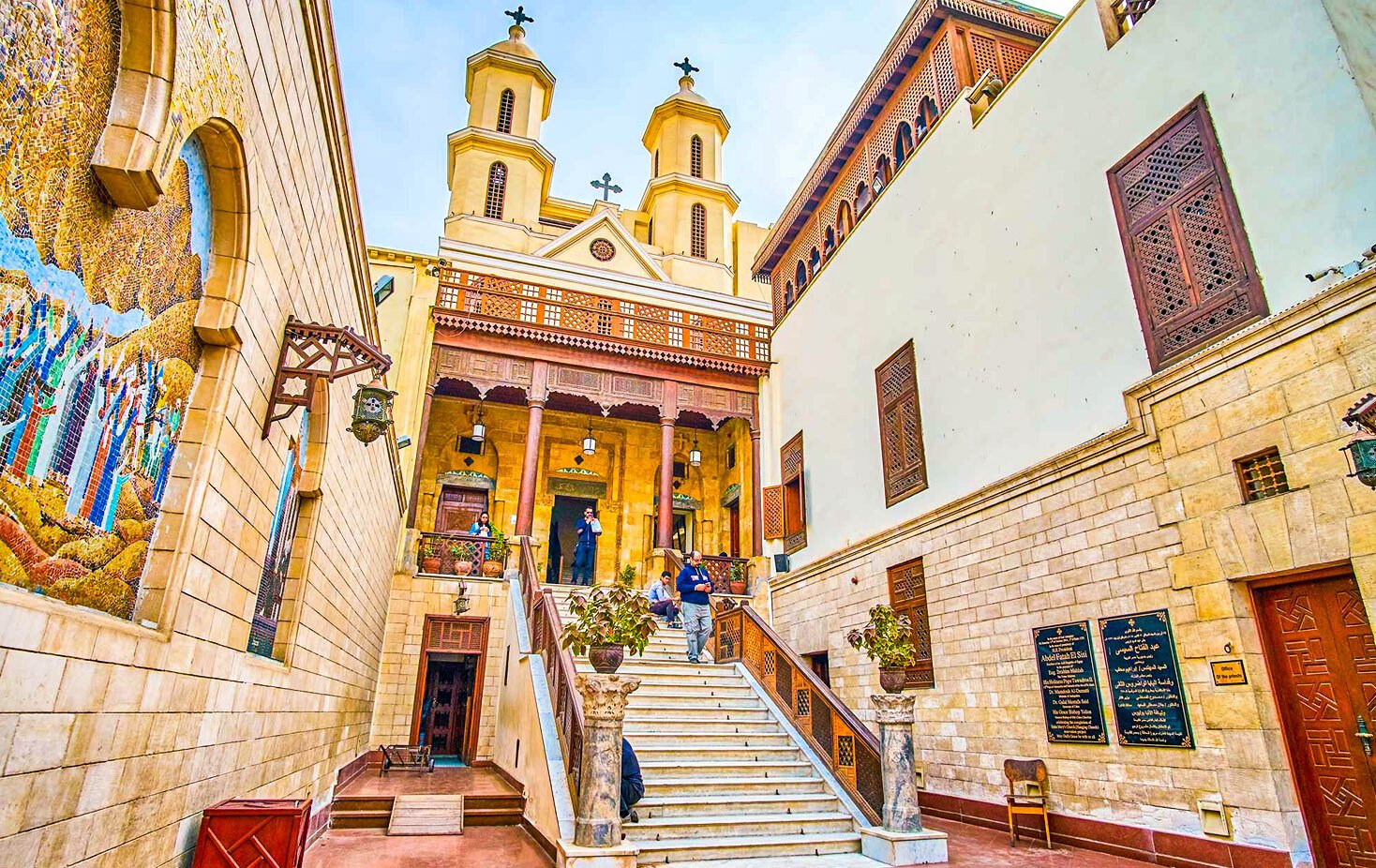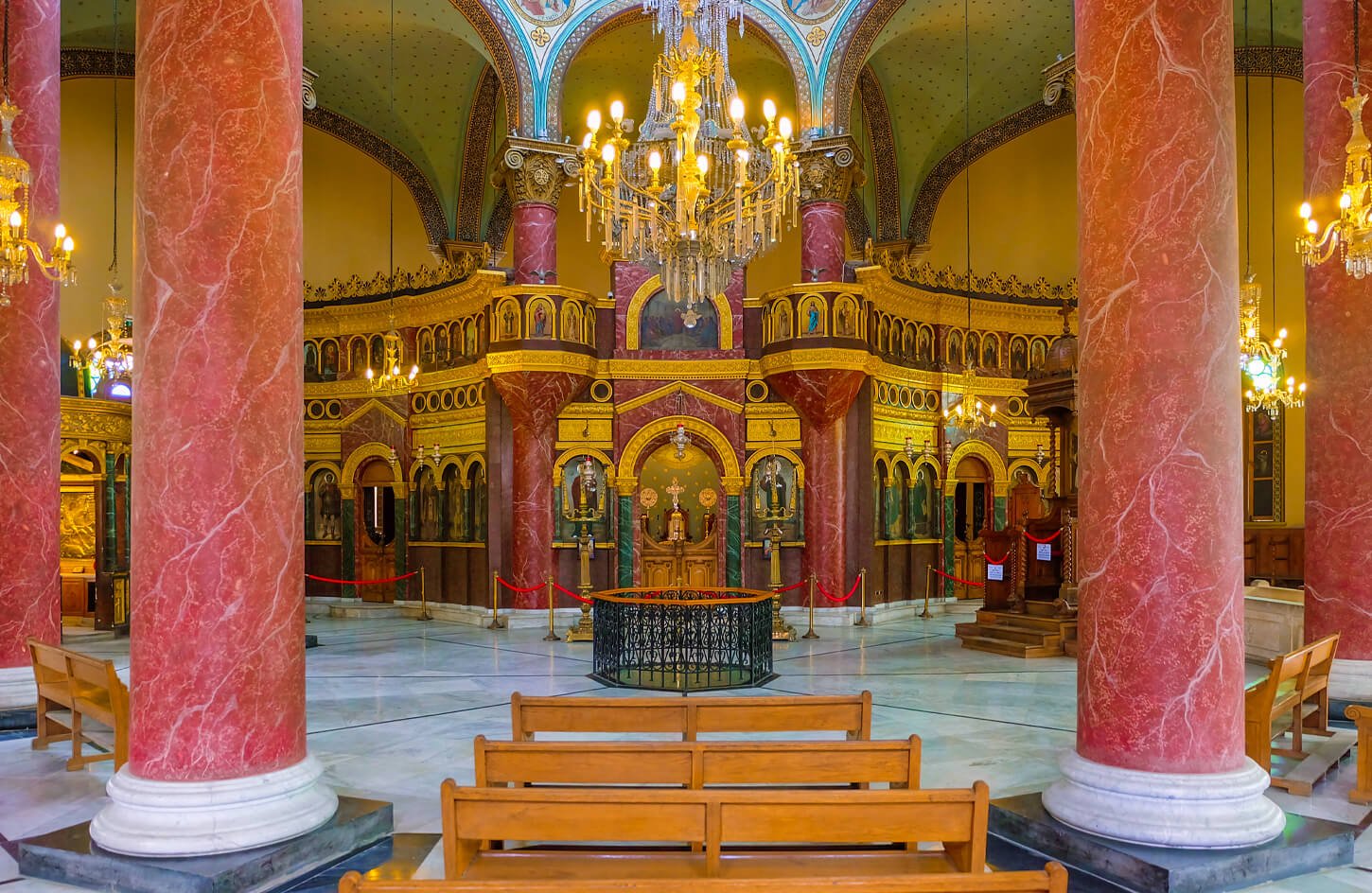Introduction
Coptic Cairo stands as a living museum of early Christianity, preserving 2,000 years of sacred history within its ancient walls. This remarkable district serves as Egypt’s spiritual heart, where Christian faith flourished since the 1st century AD. Here, narrow cobblestone alleys lead to magnificent churches adorned with Byzantine-era icons, underground crypts that sheltered the Holy Family, and museums housing priceless manuscripts. The area’s Coptic Cairo attractions include the gravity-defying Hanging Church, the treasure-filled Coptic Museum, and the legendary crypt of St. Sergius. Furthermore, ancient Roman fortress walls still guard these sacred spaces, creating an extraordinary blend of military architecture and divine sanctuaries that tells Egypt’s Christian story like nowhere else on earth.
1. The Hanging Church (Al-Muallaqa): Suspended Between Heaven and Earth

This architectural marvel appears to float above ancient Roman towers, earning its famous nickname through sheer engineering brilliance. Built in the 3rd century, it represents the pinnacle of Coptic church design.
The church’s wooden ceiling recreates Noah’s Ark, while intricate Nubian sandstone architecture frames stunning mosaics. Consequently, visitors experience both spiritual wonder and artistic mastery in one sacred space.
- Best feature: 110+ hand-painted icons depicting biblical scenes
- Hidden detail: Look for Coptic inscriptions carved into Roman stone foundations
- Photo tip: Capture light filtering through stained glass windows at 11am
- Avoid: Sunday mornings when Orthodox services draw large congregations
Did You Know? The church’s pulpit rests on 15 marble columns representing Christ and his disciples, with the 15th symbolizing Judas being made of black basalt.
Notably, the church houses Egypt’s patriarchal throne, where Coptic popes have been consecrated for over 1,000 years. Smell centuries-old incense lingering in the chapels as you explore hidden prayer alcoves.
2. Coptic Museum: Preserving 16 Centuries of Sacred Art
Founded in 1908, this museum safeguards the world’s richest collection of Coptic artifacts spanning from the 3rd to 18th centuries.
The museum’s Byzantine-era icons reveal how early Christians adapted pharaonic and Greco-Roman artistic traditions. Furthermore, precious manuscripts illuminate the development of Christian theology in Egypt.
- Must-see: The Nag Hammadi manuscripts gallery containing Gnostic gospels
- Hidden gem: Textiles with pagan-Christian fusion motifs in the basement collection
- Pro tip: Hire a museum guide to decode complex religious symbolism
- Skip: Rushing through exhibits—you’ll need minimum 2 hours here
Did You Know? The museum’s peaceful garden courtyard hides 6th-century frescoes discovered during renovations, visible only during guided tours.
The Psalms of David collection features illuminated manuscripts that survived Arab conquest, Crusades, and Ottoman rule. Consequently, these texts represent unbroken chains of Christian worship in Egypt.
3. Church of St. Sergius: Where the Holy Family Found Refuge

This 4th-century church marks Christianity’s most sacred site in Egypt, built over the crypt where Mary, Joseph, and baby Jesus sheltered during their flight.
Ancient stone steps descend into the underground sanctuary where the Holy Family lived for weeks. The crypt’s intimate space creates profound spiritual connections across two millennia.
- Sacred highlight: Original stone altar where early Christians celebrated mass
- Architectural marvel: Roman columns support the church’s wooden roof
- Pilgrimage moment: Light candles in the exact spot where Jesus slept
- Photography note: Flash forbidden in the crypt—bring high-ISO capable cameras
Did You Know? The church’s baptismal font was carved from a single piece of granite, likely recycled from a pharaonic temple.
Furthermore, the church displays rare 12th-century wooden screens (iconostasis) depicting the life of Christ. Local tradition claims miracles still occur at the Holy Family’s resting place.
4. Ben Ezra Synagogue: Testament to Religious Harmony
This 9th-century synagogue demonstrates Coptic Cairo’s remarkable interfaith history, built on the site of a 4th-century Coptic church.
The building’s Nubian sandstone architecture mirrors neighboring churches, symbolizing shared heritage between Egypt’s Jewish and Christian communities. Moreover, the synagogue preserves crucial medieval manuscripts.
- Historical treasure: The Cairo Geniza—medieval Jewish documents discovered in 1896
- Architectural detail: Moorish-style wooden gallery for women worshippers
- Hidden story: Built using stones from ancient Coptic church foundations
- Cultural significance: Last active synagogue in Old Cairo until 1960s
Did You Know? Legends claim this synagogue stands where baby Moses was found in the Nile reeds, though historians debate this tradition.
The synagogue’s restoration reveals layers of religious history. Consequently, visitors witness how different faiths coexisted peacefully for centuries in this sacred district.
5. Church of St. Barbara: Martyr’s Memorial
Dedicated to the 3rd-century Christian martyr, this church showcases exceptional Coptic ecclesiastical architecture and houses precious relics.
The church’s ornate wooden ceiling features geometric patterns inspired by Islamic art, demonstrating cultural exchange between religious communities. Furthermore, ancient icons tell St. Barbara’s martyrdom story.
- Relic highlight: Silver reliquary containing St. Barbara’s remains
- Artistic treasure: 13th-century wooden pulpit with intricate ivory inlays
- Secret chamber: Hidden room behind the altar once stored precious manuscripts
- Best visit time: Wednesday afternoons when natural light illuminates the nave
Did You Know? St. Barbara became patron saint of architects and engineers because she was imprisoned in a tower, making this church popular among Cairo’s builders.
The church’s Byzantine-era icons include rare depictions of female saints, reflecting early Christianity’s recognition of women’s spiritual authority. Notably, the baptistery contains Egypt’s oldest marble baptismal font.
6. Babylon Fortress: Rome’s Legacy in Christian Cairo
These massive Roman walls, built by Emperor Trajan around 98 AD, provided protection for early Christian communities fleeing persecution.
The fortress’s imposing towers still dominate Coptic Cairo’s skyline, creating dramatic backdrops for medieval churches. Moreover, underground passages connected various Christian sites during times of danger.
- Engineering marvel: 60-foot-tall round towers with 8-foot-thick walls
- Hidden passages: Underground tunnels linking churches (guided tours only)
- Historical layers: Roman foundations supporting Byzantine and Islamic additions
- Photo opportunity: Sunset views from fortress walls overlooking the Nile
Did You Know? The fortress name comes from “Babylon-in-Egypt,” referencing a nearby ancient Egyptian settlement, not the biblical Babylon.
Furthermore, archaeological excavations reveal continuous Christian occupation from the 3rd century. Consequently, the fortress walls witnessed the entire development of Egyptian Christianity.
7. Greek Orthodox Cemetery: Eternal Rest in Sacred Ground
This historic cemetery preserves 500 years of Greek Orthodox heritage in Egypt, featuring elaborate mausoleums and ancient burial traditions.
Ornate marble tombs showcase Byzantine artistic influences, while cypress trees create serene pathways between family plots. Moreover, the cemetery holds stories of Egypt’s once-thriving Greek community.
- Architectural highlights: Neo-Byzantine mausoleums with intricate stone carvings
- Historical significance: Graves of prominent 19th-century Greek merchants
- Hidden gems: Ancient Coptic tombstones with bilingual inscriptions
- Peaceful moments: Quiet meditation spaces among flowering shrubs
Did You Know? The cemetery contains Egypt’s oldest surviving Greek Orthodox chapel, built entirely from donations by homesick merchants.
The grounds feature rare plants mentioned in biblical texts, planted by monks who maintained the cemetery for centuries. Consequently, visitors experience both historical and botanical education.
8. St. George’s Church: Circular Sanctuary of Faith

This unique round church, built over a Roman tower, represents one of few circular Christian buildings in the Middle East.
The church’s Byzantine-era icons cover every wall surface, creating an immersive spiritual environment. Furthermore, the building’s unusual shape creates exceptional acoustics for Orthodox chanting.
- Architectural uniqueness: Only circular church in Egypt still conducting services
- Icon masterpiece: 14th-century image of St. George slaying the dragon
- Acoustic wonder: Whispers carry across the dome without echo
- Living tradition: Active Greek Orthodox congregation maintains ancient rituals
Did You Know? The church’s circular design symbolizes eternity and divine perfection, concepts central to Orthodox theology.
The altar occupies the exact center of the circle, ensuring all worshippers remain equidistant from the Eucharist. Notably, the church hosts Egypt’s most important St. George feast day celebration each April.
9. The Convent of St. George: Sanctuary of Sacred Traditions
This active convent houses Egypt’s oldest community of Orthodox nuns, preserving monastic traditions dating to the 4th century.
The convent’s chapel contains miraculous chains believed to grant blessings to visitors. Moreover, the nuns maintain ancient crafts including icon painting and manuscript illumination.
- Spiritual experience: Witness nuns performing traditional Orthodox prayers
- Sacred artifact: Iron chains worn by St. George during imprisonment
- Monastic crafts: Hand-painted icons available for purchase
- Quiet sanctuary: Peaceful courtyard garden perfect for reflection
Did You Know? The convent’s olive tree supposedly sprouted from a staff planted by a 5th-century abbess, making it over 1,500 years old.
The nuns welcome respectful visitors during specific hours, offering insights into contemporary monastic life. Furthermore, their library contains rare manuscripts copied by generations of religious sisters.
10. Underground Passage Network: Hidden Christian Highways
Beneath Coptic Cairo lies an extensive network of tunnels connecting churches, allowing Christians to worship safely during persecution periods.
These passages demonstrate early Christian ingenuity in creating protected worship spaces. Moreover, the tunnels reveal engineering skills that rival Roman aqueduct construction.
- Guided exploration: Professional tours navigate safe tunnel sections
- Historical mystery: Some passages remain unexplored due to structural concerns
- Archaeological evidence: Ancient Christian symbols carved into tunnel walls
- Engineering marvel: Precise stonework has survived 1,700+ years
Did You Know? The tunnel network extends beyond Coptic Cairo, potentially connecting to monasteries in the desert, though complete mapping remains incomplete.
Consequently, these passages represent Christianity’s underground survival during Roman persecution and later Islamic conquest. The tunnels preserve early Christian graffiti and prayer alcoves still visible today.
Conclusion: Where Faith Meets History
Coptic Cairo’s most historically significant sites—the Hanging Church, Coptic Museum, and Church of St. Sergius—collectively preserve Christianity’s remarkable Egyptian journey from persecution to acceptance. These Coptic Cairo attractions offer profound spiritual experiences within authentic historical settings.
After exploring these sacred spaces, savor authentic Egyptian cuisine at nearby local restaurants. Traditional koshary spots around Mari Girgis Station serve hearty meals that have fueled pilgrims for generations. Furthermore, small cafés near the Coptic Museum offer perfect places to reflect on your spiritual journey.
Ready to explore Egypt’s Christian heritage with expert guidance? Book our Coptic Cairo walking tour for exclusive access to restricted areas and detailed historical insights from certified local guides.
Download our free Coptic Cairo map with all 10 sites clearly marked, plus bonus locations and recommended photo spots for the perfect spiritual pilgrimage.
Check out our other articles:

